Preparing the Mortar
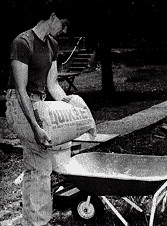 1. Mix the QUIKRETEŽ Mortar Mix or Mason Mix with water until you obtain a smooth, plastic-like consistency. 1. Mix the QUIKRETEŽ Mortar Mix or Mason Mix with water until you obtain a smooth, plastic-like consistency.
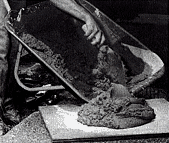
2. Make a dry run by laying a course of stretcher bricks along the chalk line for the entire length of the wall. Leave ½" between each brick for the head joints and mark the position of the bricks on the foundation with a piece of chalk. Lay this course without cutting any of the bricks; if necessary, adjust the head joint width.
3. Remove the dry course from the foundation, then throw a mortar line on the foundation. To do this, load the trowel with mortar and, as you bring your arm back toward your body, rotate the trowel deposit the mortar evenly. Mortar should be applied approximately 1" thick, 1 brick wide, and 3 to 4 bricks long. (You might want to practice throwing lines on the mortar board until you become familiar with the technique.)
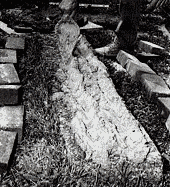 4. Furrow the mortar with the point of trowel. Divide the mortar cleanly with the trowel; do not scrape it. Good furrows not only ensure that the bricks not only ensure that the bricks are laid evenly, but they also help to squeeze out excess mortar on the sides as the bricks are set in place. 4. Furrow the mortar with the point of trowel. Divide the mortar cleanly with the trowel; do not scrape it. Good furrows not only ensure that the bricks not only ensure that the bricks are laid evenly, but they also help to squeeze out excess mortar on the sides as the bricks are set in place.
Laying the Bricks
|
1. Lay the first course of stretcher bricks in the mortar. Beginning with the second brick, apply mortar to the head joint end of each brick, then shove the bricks into place firmly so that the mortar is squeezed out of all side of the joints. Use a level to check the course for correct height, then place it on top to make sure that all the bricks are plumb and level.
2. Make sure that the head joint thicknesses correspond with your chalk marks. When you have to move a brick, tap it gently with a trowel handle; never pool on it because this breaks the bond. Be sure to trim off any excess mortar for the sides of the bricks.
|
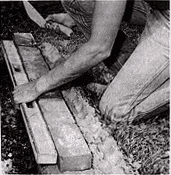
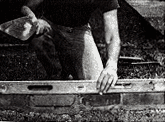 |
3. Throw another mortar line alongside the first course, then begin laying the second, or backup, course. Use the level to make sure that the two courses are equal height, but do not mortar them together.
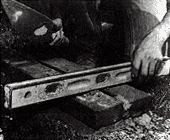
4. Before beginning to lay the second, or header, course, cut two bricks to half length. To cut a brick, lay it on the ground and score it all the way around using a hammer and brick set. Break the brick in two with a sharp blow to the brick. Note: When cutting bricks, protect your eyes by wearing goggles.
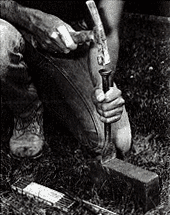
5. Use the two half bricks to begin the second, or header, course. This will ensure that the first two courses are staggered for structural purposes.
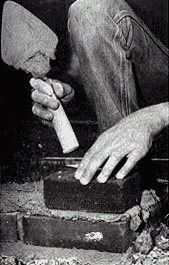
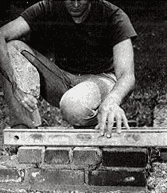 6. To finish the second course of the lead, lay three header bricks and make sure that they are plumb and level. As seen in the photo, the third and fifth courses consists of stretchers similar to the first course; the fourth course begins with single header, followed by stretchers. Use the level to make sure that the lead is true on each course. 6. To finish the second course of the lead, lay three header bricks and make sure that they are plumb and level. As seen in the photo, the third and fifth courses consists of stretchers similar to the first course; the fourth course begins with single header, followed by stretchers. Use the level to make sure that the lead is true on each course.
7. Build another lead on the other end of the foundation. As the mortar begins to set, it is best to stop laying bricks and use a concave jointer to finish the mortar joints. Work along the vertical joints first; this will help as improve the appearance of the wall.
Filling in the Leads
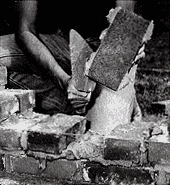 1. Stretch a mason's line between the completed leads, then begin laying the outer course. The line should be approximately 1/16" away from the bricks and flush with their top edges as shown. Work from both ends of the wall toward the middle. When you reach the final brick, mortar both sides of it and push it straight down to squeeze the mortar out from the joints. | 1. Stretch a mason's line between the completed leads, then begin laying the outer course. The line should be approximately 1/16" away from the bricks and flush with their top edges as shown. Work from both ends of the wall toward the middle. When you reach the final brick, mortar both sides of it and push it straight down to squeeze the mortar out from the joints. |
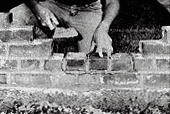
2. Move the mason's line to the back of the wall and begin laying the backup course. Remember to check your work with level for accuracy and finish the joints with the concave jointer when they are almost dry.
3. The fifth, or top, course is laid exactly like the first. Move the mason's line up, throw a mortar line, and begin laying the bricks. Apply a generous amount of mortar on the face of each brick, then shove the brick firmly into place.
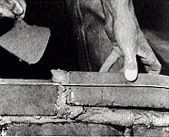
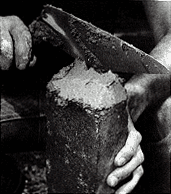
4. To build a higher wall, simply build more five-course leads at each end of the wall. Keep in mind that some type of reinforcing should be used for higher walls.
5. Scoop mortar onto the trowel and use the concave jointer to fill in the joints on the top course. Keep a careful check on the joint thickness as you go. When you have laid the last brick, check the top course for assignment.

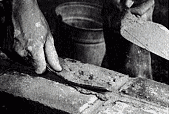
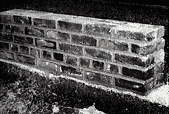
Building Corners
A wall with corners is not much harder to build that the basic freestanding wall. The following directions show how to build a corner in the common bond pattern, but they can be adapted to any of the other patterns as well.
1. Snap chalk lines on both sides, then check to make sure that they are perfectly square using a carpenter's square or the 3-4-5 method.
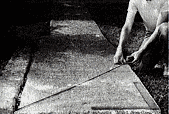
2. Make a dry run to make the position of the bricks. Throw a mortar line, then place the first brick exactly at the corner, being careful to line it up with a chalk lines.
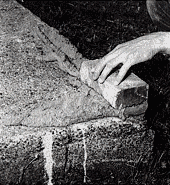
3. Lay the four remaining bricks in the first course of the lead. With the level and/or carpenter's square, check the alignment and make sure that the bricks are level and plumb.
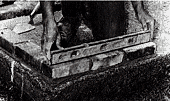
4. Throw mortar lines and lay the back-up course as shown. Both courses should be level with one another; there is no mortar joint between the two.
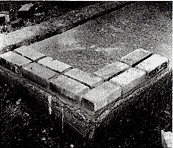
5. To lay the second course, cut two bricks into quarter and three-quarter pieces. Begin by laying the three-quarter brick pieces perpendicular to one another to form the out edge of the corner. Continue by laying several header bricks out from the corner. Finally, complete the second course by inserting the two quarter closure bricks as shown.
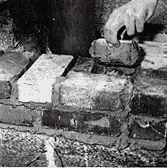
6. Lay courses 3 through 5 to finish the corner lead. Courses 3 and 5 are similar to course 1; course 4 begins with a header positioned as shown.
7. Construct a second lead at the opposite corner.
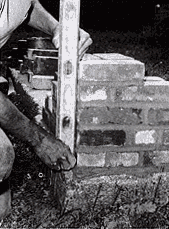 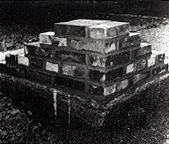
Other Types of Bonds
In addition to the common bond pattern, there are a number of other patterns from which to choose. By using the previous directions for laying the common bond, you can use any of these patterns to give variety to your bricklaying work.
Running Bond. This is the simplest pattern; it consists of only stretchers. Reinforcing ties are usually used with it because of the absence of headers. Running bond is common in brick veneer walls and wall cavity construction.
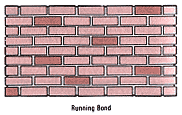
Common or American Bond. As detailed in the step-by-step instruction, this is a variation of the running bond, with a course of full-length headers placed at regular intervals for structure bonding.
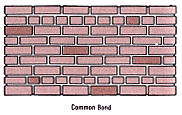
Flemish Bond. This pattern uses alternate stretchers and headers, with the headers in alternate courses centered over the stretchers in the intervening courses.
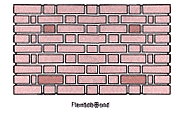
English Bond. This pattern also uses alternate stretchers and headers, but the headers are centered on the stretchers and the joints between the stretchers in all the courses in line up vertically.
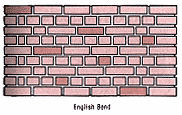
English Cross or Dutch Bond. This is a variation on the English, the only difference being that the vertical joints between the stretchers in alternate courses do not line up vertically.
These joints center on the stretchers themselves.
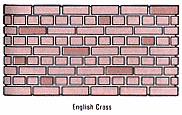
Stack or Block Bond. This is a week bond, used normally for decorative effect on veneers. All vertical joints are aligned, and steel reinforcing ties must be installed if the pattern is being used structurally.
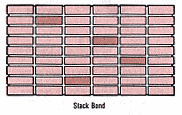
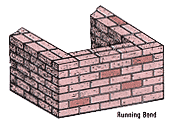 
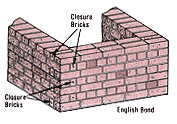 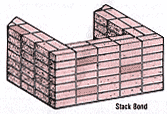
Joints
There are several commonly used methods of finishing method based on the type of construction. The best joints for strength and waterproofing are concave and V-joints. A weathered joint is also strong and the most watertight. Raked, struck, and extruded joints are perhaps the most dramatic looking; however, they are not very water-resistent. Care should be taken using them in rainy or freezing climates. A flush joint is the simplest joint-excess mortar is simply cut off with trowel. But this joint is not particular strong or water-resistant.
 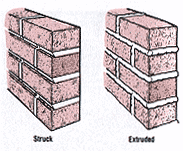
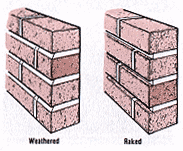 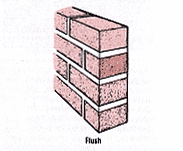
Pillars and Posts
The first step in making pillars and posts of masonry units is to construct adequate footings.
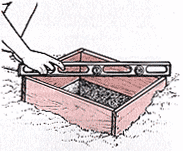
1. Make the forms. If the top surface of the footings will be level with or below the grade, cut the forms directly in the soil. If the surface of the footing will be above grade, use a shallow wood form in conjunction with a cavity cut in the soil.
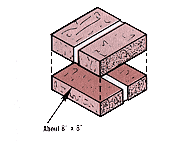 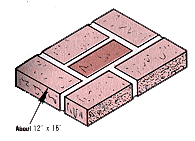
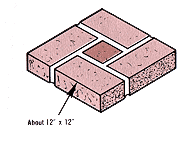 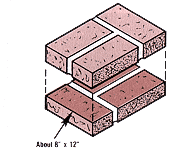

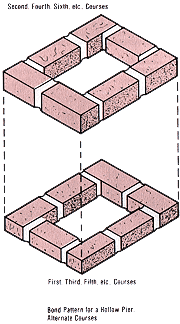
2. Mix QUIKRETEŽ Concrete Mix and pour it into the form
3. When all standing water has evaporated, use a trowel to smooth the surface of the footing.
4. Moist-cure the concrete. Once the footings have set, continue pillar and posts construction as you would if you were building a full wall. Use a level frequently to check the horizontal plane of each course and the plumbness of each wall.
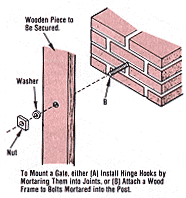 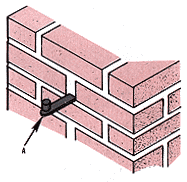
Use a large carpenter's square to ensure that the corners are square. Cap the pillar or post with pre-cast concrete slabs, hand-formed mounds of QUIKRETEŽ Concrete or Mortar, removable wood caps, or pieces of flagstone.
For Best Results
- Be sure that dirt walls are vertical or that they slant out slightly at the base.
- Be sure that the base for the footing is firm and level.
- Check to see that the surface of the wood form is level
- Add vertical steel reinforcement rods or conduct for electrical cable.
- Add brackets, bolts, studs, hinges, light fixtures, and/or hangers before the concrete or masonry has set.
- Install the cap at a slight angle so that it sheds water.
Edging
Brick edging is the perfect completion to concrete walkways and patios.
1. Stake out the areas for the edging using measuring tape and twine. The width of the edging should be equal to the length of the brick being used-usually 8".
2. Remove the sod and soil to a depth equal to the width of the brick -usually about 4".
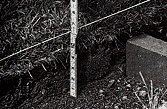
3. Use one of the bricks to tamp down the excavation and make it as smooth as possible.
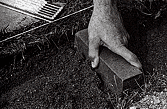
4. Prepare the QUIKRETEŽ Mortar Mix or Mason Mix; then spread a layer in the excavation for the bricks.
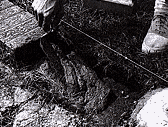
5. Set the bricks in place by applying mortar to one side and pressing each brick firmly against the preceding one.
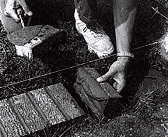
6. To adjust a brick, tap it with the trowel handle; never pull on it because this breaks the bond. Use the trowel to trim off any excess mortar from the topes of the bricks as you go.
7. With this simple construction technique, you can even make curved edging. Just dig the excavation to the desired curve, taking care to keep the width the same at all times.
|
